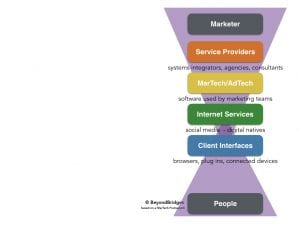What About People?
Spotted this in my feeds today …
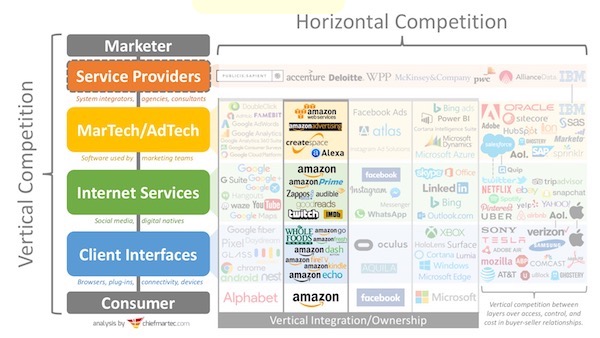 You can find the original here - along with the associated article by ‘Chief Martech’ Scott Brinker. Anyone spot the problem?
You can find the original here - along with the associated article by ‘Chief Martech’ Scott Brinker. Anyone spot the problem?
Before reading on - Scott’s excellent piece about Amazon’s acquisiton of Wholefoods is not what this article is about. Though I will probably extend that on another occasion. No, rather it is the thinking behind the model that he uses to support his case.
Answer … every level in the stack has software associated with the role except ‘we the people’ - or ‘consumer’ as the chart would have it. As usual, I am in general accord with Scott’s writing and thinking. He writes after all from the perspective of MarTech, no rocket science there and delivers what it says on the tin in an engaging way. But sometimes - just sometimes, I do feel that opportunities to broaden the tent are missed. I last wrote and commented in November on another MarTech post, but more recently another couple came up … example ….
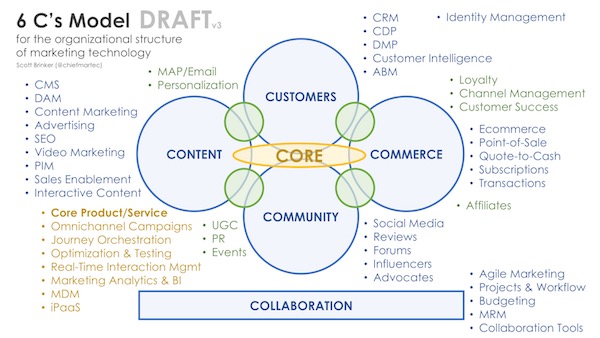
May 24th : A proposed model for organizing the chaos of marketing technology I tweeted at the time … but of course no one was listening :-) but to save you the click through let me reiterate … why on earth in 2017 is the Customer not at the center of a visual aid that is all about marketing technology.
May 10th : Over 5000 marketing technology solutions
To be honest, trying to make sense of anything here would be a herculean task - so I haven’t - but a quick scan does reveal that the solutions being tracked are what I would call ‘enterprise centric’. Again - not surprising, that is the focus of MarTech. 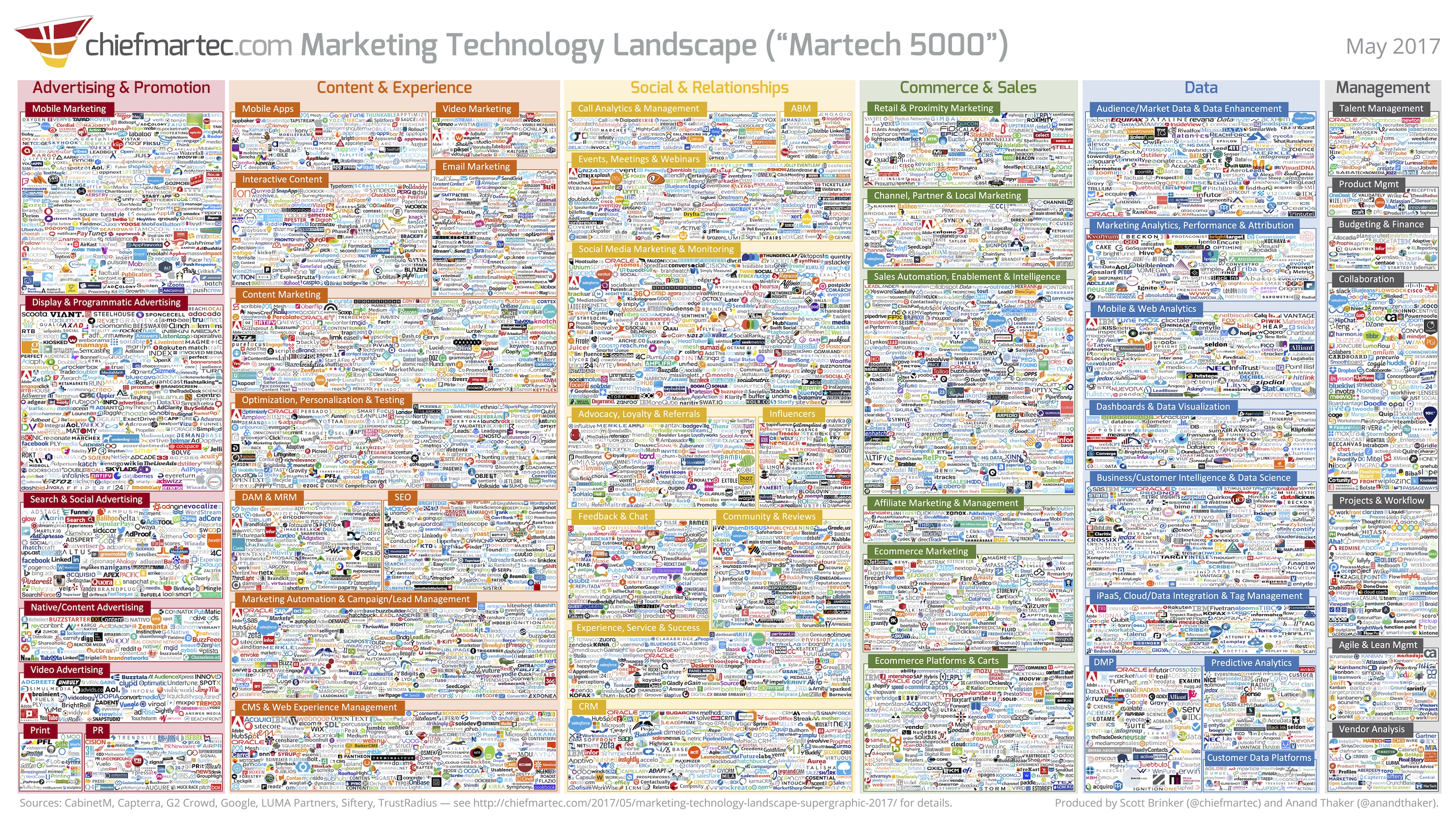
But
…. all of this wouldn’t be so bad had not Doc Searls - he of The Cluetrain Manifesto, The Intention Economy and a ten-year-old initiative on (for the want of a better description) customer empowerment. It is what we used to call ‘VRM’ - and is now transitioning to something we now call #CustomerTech - essentially a play off the existing #MarTech and #AdTech tag/abbreviation conventions that are already in common use.
Check out Customer Commons to learn more
This is not fluff, it was driven originally from The Berkman Institute at Harvard and Doc spoke at Scott’s recent conference about it. No need for me to replay it all, you can read the summary for yourself here. It’s an article by Barry Levine from May 12th of this year on ‘MarTechToday.com’ - which I THINK along with martechconf.com are conference sister sites to Scott’s own ChiefMartec.com site. So there is no doubt that Scott knows about Docs work. But there’s more …. GDPR rolls out in Europe next year
It requires that consumers provide explicit consent for the use of their personal data, which includes their online behavior. It applies to marketing directed at EU citizens, wherever they may be, and it provides for significant penalties. If it’s enforced, brands and consumers in Europe are likely to be profoundly affected. But, since GDPR applies to EU citizens wherever they are, it could also seriously impact brands and consumers in the US and elsewhere.
I remain unclear as to whether organisations …
- just don’t know about this (hard to imagine but heh - it’s an option),
- know about it but for some reason feel it won’t apply to them (it will), or
- are just simply doing ostrich impersonations (read on).
 Of course - it could be that all those people with their heads in the sand have them there for the real reasons that Ostriches have their heads in the sand. It isn’t because they are hiding - it is because they are nurturing … readying their family for the next generation …
Of course - it could be that all those people with their heads in the sand have them there for the real reasons that Ostriches have their heads in the sand. It isn’t because they are hiding - it is because they are nurturing … readying their family for the next generation …
When nesting, they dig shallow holes in the ground to use as nests for their eggs. They use their beaks to turn their eggs several times each day. From a distance, an ostrich leaning into a hole to turn an egg could easily look like it’s burying its head in the sand!
Yes. the optimist in me says that people know Ostriches better than we think and they are really nurturing for a better future.
OK, back to reality …
We have great services and article from Scott and his team with Martech. This is absolutely not a ding on him or the site at all - but I do think that we sometimes need to be a little more embracive of related ideas. Scott and the MarTech team know about the initiative that Doc is driving. Customer Commons as a name is new but the underlying thinking and work is not - ten years and counting. So not unsupported. In fact over two hundred companies around the world are working on solutions in this space - and that’s just what you can count up here … and let me tell you the range of products that are under development is extensive … Personal Assistants and Information Managers, Privacy Protection, Secure Messaging, Dispute Resolution, Social Aggregators, Protocols for Managing Data Provenance, Personal Data Control, even a new Browser that I have to say is spectacular … and and and …. and it isn’t all in a vacuum Iceland (the country), Santander, Salesforce, BBC, Aimia, British Telecom, Intel and many more are all customers to the companies in this collective, with investments coming in from very interesting new areas like The Omidiyar Network as well as the more obvious sources like Khosla and Y Combinator. So I wonder what it would take to include the #CustomerTech thinking and ideas into the models that get shared in business. After all, it’s important. Here is a suggested start that I just pulled together. Click on any of the images to get a full-size version.
First Repeat Scott’s Original Diagram
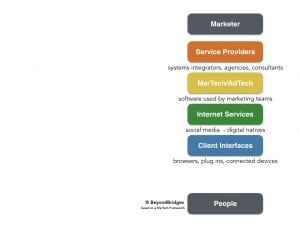 Notice - I have made two changes;
Notice - I have made two changes;
- I have chosen to use the word ‘people’, not ‘consumer’ in the bottom box. I think a modern brand wants to engage with, have relationships with, build trust with people. Consumers is so … oh what’s the word …
- I have left space between Client Interfaces and ‘People’. Read on to see why.
Map where the software power lies … I have used purple triangles to highlight how the stack is weighted towards the Marketer and … that is where the software power resides …. integrators, agencies, consultants, software, marketing teams … all on the same team - to get ‘we the people’ to buy stuff. Because that is ‘the machine’ in action. But wait - I am not a number - I am a free man! Prescient stuff when you think about it - 50 years ago what did Number 2 want? Information. Same as it ever was. Trouble is 50 years later it has got so much worse.
Introduce #CustomerTech
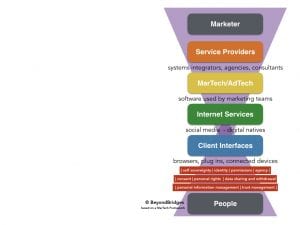 The software, systems, solutions and protocols that make up #CustomerTech is extraordinarily varied - as are the resultant benefits to ‘we the people’. But some key phrases that you should be concerned about include self-sovereignty, permissions, trust management and all of those other phrases that have now appeared in those red boxes that in simple terms will work as a defence to the ever encroaching engines that increasingly suck out our data into their silos for merging and manipulating so that the brands can ‘engage’ with us. A long long time ago I had an email signature : “I am my own system of record” - as a comment that I was indeed the person that owned my data - and not some data wonk in the bowels of the CitiBank building, or Government , or Visa. #CustomerTech is the beginning of that change. < p class=“postguide”>Level the Playing
Field
The software, systems, solutions and protocols that make up #CustomerTech is extraordinarily varied - as are the resultant benefits to ‘we the people’. But some key phrases that you should be concerned about include self-sovereignty, permissions, trust management and all of those other phrases that have now appeared in those red boxes that in simple terms will work as a defence to the ever encroaching engines that increasingly suck out our data into their silos for merging and manipulating so that the brands can ‘engage’ with us. A long long time ago I had an email signature : “I am my own system of record” - as a comment that I was indeed the person that owned my data - and not some data wonk in the bowels of the CitiBank building, or Government , or Visa. #CustomerTech is the beginning of that change. < p class=“postguide”>Level the Playing
Field 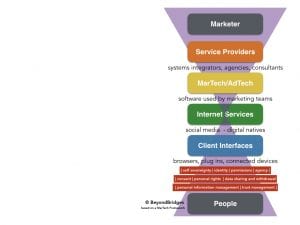 .. and so the final change in the flow - a slight distribution of those purple triangles - no longer overlapping - but instead touching that allows through permissions and trust to engage equally when both parties want to. What do you think Scott - should we get together and work this through in more detail?
.. and so the final change in the flow - a slight distribution of those purple triangles - no longer overlapping - but instead touching that allows through permissions and trust to engage equally when both parties want to. What do you think Scott - should we get together and work this through in more detail?
